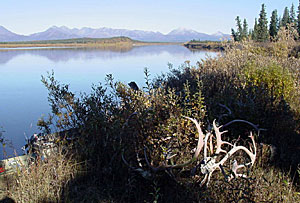FROM ADF&G
 Most Alaska hunting seasons begin in August and September and end by October. Seasons in some areas continue into the winter months. In locations where certain animal populations are large enough and local subsistence needs are being met, hunting for some species may be permitted all year. Bears may be taken in either fall or spring in some locations.
Most Alaska hunting seasons begin in August and September and end by October. Seasons in some areas continue into the winter months. In locations where certain animal populations are large enough and local subsistence needs are being met, hunting for some species may be permitted all year. Bears may be taken in either fall or spring in some locations.
Timing is important for particular species, like caribou and waterfowl. Caribou migrate seasonally, and an area that provides good hunting in August may be almost devoid of caribou in September. Most waterfowl move quickly out of Alaska in early fall.
Weather, vegetation, and topography vary widely in Alaska. The following table generally describes these features by region and game management unit (GMU), and by time of year (fall versus spring).
Alaska Weather, Vegetation and Landforms by Region
| Region | August–Sept Weather | April–May Weather | Vegetation | Landforms |
|---|---|---|---|---|
| Southeast (GMUs 1–5) | Temperatures are mild and may be warm. Skies are typically overcast, with some sunny days. Drizzle and rain is normal. | Temperatures are cool to warm. Sunny days are normal, but some rain can be expected. | The region is heavily forested with large trees and dense undergrowth. Alpine areas and muskegs are open. | Nearly the entire region is comprised of mountains and fjords with many islands. |
| Southcentral (GMUs 6, 7, 11, 13–16) | Temperatures are normally mild, but may be cold at night. Weather tends toward rainy, but there will normally be many sunny days. Snow is possible in September and likely in October. | Temperatures are cool. Sunny days are the norm, but rain can be expected at times. Snow is possible, especially in April. | Vegetation varies widely from heavy forests in river valleys to open hillsides with low-growing alpine and sub-alpine shrubs. | Much of the region is hilly or mountainous. There are a number of large river valleys and basins. |
| Southwest (GMUs 8–10, 17) | Weather is typically cool, wet and windy. Snow is possible in October storms. | Temperatures gradually warm during the spring. Cool, wet and windy is also the norm at this time of year. | Forest cover is limited in much of this area. Shrubs and low-growing plants replace trees to the north and west. | Small mountain ranges punctuate the landscape, but much of the area is low rolling hills. |
| Interior (GMUs 12, 19–21, 24, 25) | Weather is typically cool and occasionally cold. Precipitation is not great, but August and September are among the rainiest months. Snow is possible in September. | Temperatures range from below freezing at night to highs in the 60s late in the season. The sky is typically clear with limited precipitation. Snow is possible, especially at higher elevations. | Forest cover is extensive in river valleys, but gives way with increasing altitude to sub-alpine and alpine vegetation. | With the exception of large river flats with many small lakes, much of the area is dominated by hills, which grow to high peaks in the Alaska Range, the Brooks Range and other lesser ranges. |
| Western (GMUs 18 & 22) | August can be warm, but tends toward rainy and cool. Cool, rainy conditions are normal in September with storms coming off the Bering Sea. | Break up is earlier in GMU 18, with winter conditions persisting into April in GMU 22. Snow travel conditions are typically poor in GMU 22 in May. | Trees are sparse or absent over much of the area. Low-growing shrubs, grasses and sedges dominate. Trees occur in the eastern portion of both units. | Much of GMU 18 is wet lowland, rising to mountains in the north and east. GMU 22 is mostly hilly, rising to low mountains in places. |
| Arctic (GMUs 23 & 26) | Expect cool weather during the day and cold temperatures at night, especially in September. | Prepare for cold weather and snow. Weather becomes cool in May. | There is very little forest cover in the Arctic. The vegetative cover consists largely of low-growing shrubs, grasses and sedges. | The arctic coastal plain is made up of low hills and many small lakes. The hills to the south rise to the Brooks Range. |
A Hunter's Calendar for Alaska
| Please see the current Alaska Hunting Regulations for details of specific seasons. | |
|---|---|
| Jan: | New hunting licenses, bear tags, nonresident big game tags needed. |
| Feb: | Plan your hunting trip. Call for information. |
| March: | Drawing and Tier II permits awarded. |
| Apr: | Alaska Board of Game prepares regulations for the next hunting season. Most spring bear seasons open. |
| Jul: | Regulatory year begins. New hunting regulations booklets available. New harvest tickets for the regulatory year. |
| Aug– Sept: | Most fall hunting seasons begin. Some Dall sheep, caribou, deer, and moose seasons open. Obtain harvest tickets and/or registration permits for big game before hunting. Turn in harvest reports within 15 days of the close of the season. |
| Nov: | Drawing and Tier II permit materials available. Some late winter moose hunts open. |
| Dec: | Drawing and Tier II permit applications accepted November 1–December 31 only. |

No comments:
Post a Comment